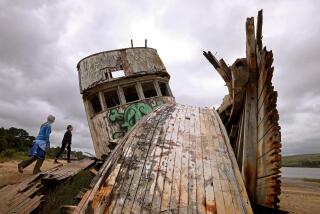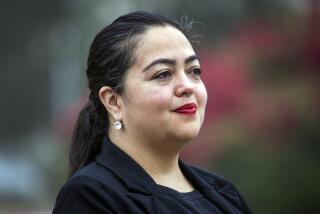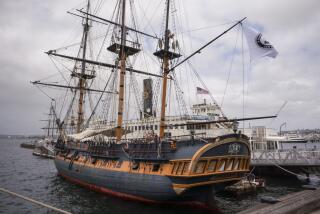A Seafarer’s Lasting Imprint
He probably never set foot on the beach that bears his name. He may not even be buried on the island where a memorial marker has stood for nearly seven decades.
But none of that matters to a group of history-loving San Pedro residents and volunteers. For 37 years, on the first Saturday after Labor Day, the group that calls itself the Cabrillo Landing Party disembarks ceremonially on San Miguel Island. There, they reenact the landing of Juan Rodriguez Cabrillo, the first European known to have set eyes on the California coast.
Cabrillo Beach in San Pedro is named for him, as is Cabrillo Marine Aquarium, where many members of the landing party volunteer as docents. And the marker on San Miguel Island, the most remote in Channel Islands National Park, pays tribute to Cabrillo as the “Discoverer of California” and denotes San Miguel as his “Isle of Burial.”
The six volunteers, dressed as conquistadors and clergy, hoist the flags of Spain and Portugal (Cabrillo’s nationality has been disputed for centuries). Their leader, playing Cabrillo, is John Olguin, 84, retired director of the aquarium. He greets the 40 to 50 spectators on the beach who represent the Native Americans thought to be Cabrillo’s welcoming party.
“This is what it looked like when I landed over 4 1/2 centuries ago,” Olguin tells the crowd. “No McDonald’s or Taco Bells.”
Olguin (pronounced ol-GEEN) has portrayed either Cabrillo or a soldier for nearly four decades. His great-grandmother, he said, was a Chumash from San Luis Obispo, and some of his ancestors may have greeted Cabrillo. Olguin and his wife named their only child John Cabrillo Olguin.
Cabrillo served with Hernando Cortez, who conquered the Aztecs between 1519 and 1521. Later, Cabrillo led an expedition north to forge an empire for Spain and to seek new opportunities for trade with China.
The fate of Cabrillo -- an experienced soldier, shipbuilder, crossbowman and mariner -- is hazy. He set sail from Mexico in June 1542, but even the number of ships is disputed. Some accounts say two, others three: the La Victoria, the San Miguel and the San Salvador.
Cabrillo’s original log was lost; much of what we know comes from a summary of testimony from expedition participants, taken 16 years later.
Three months into the voyage, on Sept. 28, the explorers reached San Diego Bay. A party went ashore and encountered three fearless natives standing their ground. Later that evening, more crewmen went ashore to fish. The natives shot and wounded three with bows and arrows, according to the sailors’ summary of the expedition.
The fleet pressed on, landing at what is now Catalina Island, where they found friendly natives. On Oct. 8, they entered a large bay on the mainland, which they named Baya de los Fumos, for the many fires they saw. The blazes were believed to have been set to flush out game, but Olguin has a different theory.
“I think they were smoke signals,” he said. “There’s an Indian legend of a big white canoe with big white wings. The natives were alerting other tribes ... of the legend coming true.”
Here, at what is thought to be modern-day San Pedro, the expedition dropped anchor and the local Indians visited, exchanging gifts. Cabrillo probably did not disembark or set foot on the beach that bears his name.
The next day, he sailed on, anchoring overnight in a cove now known as Santa Monica Bay. On Oct. 10, they continued north, hugging the coastline, and found a thriving Chumash village. They named it Pueblo de las Canoas, for the many fine canoes that carried dozens of curious Indians out to greet the fleet. Most historians contend this took place at what is now Point Mugu in Ventura County, but others say it was Malibu Lagoon.
The little fleet then sailed through the Santa Barbara Channel, anchoring off Gaviota Pass, where the Indians brought them fresh sardines.
On Oct. 18, heavy winds near Point Conception forced the ships to turn south and take shelter on San Miguel Island, where they stayed for a week. The sailors described a big welcome -- the event that Olguin and his group re-create every year. Nearly 500 Native American villages and camping sites were found centuries later on the tiny island, hinting at a large settlement in Cabrillo’s time.
When the weather cleared, they headed north again but missed the opening to San Francisco Bay. They turned back at the Russian River and sheltered briefly in Monterey Bay before part or all of the armada returned to San Miguel to repair their ships, which were leaking.
This is where the story gets murky. Historian Harry Kelsey, who published the biography “Juan Rodriguez Cabrillo” in 1986, believes the bedraggled fleet returned to Catalina on Nov. 23 to spend the winter. Here is his version of events:
Relations with the natives deteriorated. After a series of altercations between them and Cabrillo’s men, some sailors went ashore to get water on Christmas Eve. They were attacked and yelled for help.
Cabrillo rowed ashore with a rescue party. “ ‘As he began to jump out of the boat,’ a sailor said, ‘one foot struck a rocky ledge and he splintered a shinbone,’ ” Kelsey wrote. “One account says he broke an arm close to the shoulder. Another says he broke both an arm and a leg.”
Cabrillo was taken back to the ship, where he developed gangrene. “He died on Jan. 3, 1543, and was buried on the island ... ,” Kelsey wrote. His grave has never been located.
Other historians say this happened on San Miguel or Santa Rosa islands.
“We’ll never know which island he was buried on because of longitude not being measured with exactitude,” said Doyce B. Nunis Jr., distinguished professor emeritus of history at USC. Latitude was estimated using the stars or the sun. It would be another two centuries before ships carried chronometers, and a century after that, sextants and almanacs.
Cabrillo’s nationality is as disputed as his gravesite. The confusion grew out of a 16th century historian’s reference to his being Portuguese, which no one had claimed before. That was repeated for centuries. In 1937, the Cabrillo Civic Clubs of California, a statewide Portuguese group, commemorated Cabrillo with a monument overlooking the San Miguel harbor.
Kelsey, the biographer, spent eight years tracing Cabrillo’s life from the Archives of the Indies in Seville, Spain, and the National Library in Madrid. He discovered that Cabrillo was born in Spain, probably around 1498 or 1500 -- not in Portugal.
As for the expedition, Cabrillo’s chief pilot, Bartolome Ferrelo, or Ferrer, took charge. He sailed north, possibly as far as Oregon, before turning his battered fleet around and returning to Mexico on April 14, 1543. Their voyage was considered a failure because they had not reached China.
More to Read
Sign up for Essential California
The most important California stories and recommendations in your inbox every morning.
You may occasionally receive promotional content from the Los Angeles Times.










